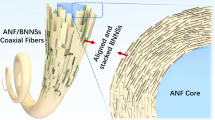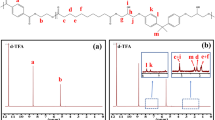Abstract
Bioplastics are gaining interest due to their biodegradable and biocompatible nature which can be used as a replacement for petroleum based plastics. Poly (3-hydroxybutyrate-co-15 mol% 3-hydroxyhexanoate) [P(3HB-co-15 mol% 3HHx)]/ZnO nanoparticles (NPs) blended bioplastic films were fabricated by solution casting method using chloroform as solvent. The structural characteristics such as peak intensity analysis, crystallite size, dislocation density, and texture coefficient of ZnO NPs mixed P(3HB-co-15 mol% 3HHx) samples were studied using X-Ray Diffraction (XRD) and Fourier Transform Infra-Red (FTIR) analyses. It is clear from the XRD analyses that the crystallinity of P(3HB-co-15 mol% 3HHx) was decreased considerably as ZnO NPs concentration increased. The crystallite size of P(3HB-co-15 mol% 3HHx) was decreased with an increase in ZnO NPs concentration and observed within 150 nm and the dislocation density was decreased with respect to the orientation of P(3HB-co-15 mol% 3HHx) crystals. Simultaneously, the structural properties of ZnO NPs in P(3HB-co-15 mol% 3HHx) matrix were affected noticeably with respect to the ZnO NPs and copolymer concentrations. The characteristic peak positions from FTIR spectra of P(3HB-co-15 mol% 3HHx) copolymer shifted towards higher frequency and evidenced the existence of structural defects. Overall, it was found from both XRD and FTIR analyses that the presence of ZnO NPs affected the crystallinity of P(3HB-co-15 mol% 3HHx) copolymer due to the formation of intermolecular bonds, which restricted the preferential orientation of P(3HB-co-15 mol% 3HHx) molecules which was observed from the texture coefficient analyses. Based on these observations, ZnO NPs at low concentrations can be used with P(3HB-co-15 mol% 3HHx) copolymer effectively and the resulting composite may be used for packaging application.









Similar content being viewed by others
References
Sanchez-Garcia MD, Gimenez E, Lagaron JM (2008) Carbohydr Polym 71(2):235–244
Flechter A (1993) Plastics from bacteria and for bacteria: PHA as natural, biodegradable polyesters. Springer, New York
Abdelwahab MA, Flynn A, Chiou B-S, Imam S, Orts W, Chiellini E (2012) Polym Degrad Stab 97:1822
Avella M, De Vlieger JJ, Errico ME, Fischer S, Vacca P, Volpe MG (2005) Food Chem 93:467
Khanna S, Srivastava AK (2005) Process Biochem 40:607
Steinbüchel A, Valentin HE (1995) FEMS Microbiol Lett 128(3):219–228
Galego N, Rozsa C, Sanchez R, Fung J, Vázquez A, Santo Tomas J (2000) Polym Test 19:485
Steinbüchel A, Füchtenbusch B (1998) Trends Biotechnol 16:419
Wu CS (2006) J Appl Polym Sci 102:3565
Jain R, Kosta S, Tiwari A (2010) Chron Young Sci 1:10
Keenan TM, Tanenbaum SW, Stipanovic AJ, Nakas JP (2004) Biotechnol Prog 20(6):1697–1704
Kahar P, Tsuge T, Taguchi K, Doi Y (2004) Polym Degrad Stab 83:79
Sudesh K, Abe H, Doi Y (2000) Prog Polym Sci 25:1503
Xu C, Qiu Z (2011) Polym Adv Technol 22:538
Sadat-Shojai M, Khorasani M-T, Jamshidi A, Irani S (2013) Mater Sci Eng C 33:2776
Bitinis N, Hernández M, Verdejo R, Kenny JM, Lopez-Manchado MA (2011) Adv Mater 23(44):5229–5236
Vaseem M, Umar A, Hahn Y.-B (2010) (American Scientific Publishers, New York), p 1
Díez-Pascual AM, Díez-Vicente AL (2014) Int J Mole Sci 15:10950
Yu W, Lan C-H, Wang S-J, Fang P-F, Sun Y-M (2010) Polymer 51:2403
Ye HM, Wang Z, Wang HH, Chen GQ, Xu J (2010) Polymer 51(25):6037–6046
Oliveira FC, Dias ML, Castilho LR, Freire DM (2007) Bioresour Technol 98:633
Devi AB, Nachiyar CV, Kaviyarasi T, Samrot AV (2015) Int J Pharm Pharm Sci 7(3):140–144
Liau CP, Bin Ahmad M, Shameli K, Yunus WMZW, Ibrahim NA, Zainuddin N, Then YY (2014) Sci World J 2014:1–9. doi:10.1155/2014/572726
Nair AM, Annamalai K, Kannan SK, Kuppusamy S (2014) Malaya J Biosci 1:8
Thire RMDSM, Arruda LC, Barreto LS (2011) Mater Res 14:340
Rithin Kumar N, Crasta V, Bhajantri RF, Praveen B (2014) J Polym 2014
Makinson J, Lee J, Magner S, De Angelis R, Weins W, Hieronymus A (2000) Adv X-Ray Anal 42:407
Guo W, Duan J, Geng W, Feng J, Wang S, Song C (2013) Microbiol Res 168:231
El-Kader FA, Hakeem N, Elashmawi I, Ismail A (2013) Aust J Basic Appl Sci 7:608
Venkateswarlu K, Sandhyarani M, Nellaippan T, Rameshbabu N (2014) Proced Mate Sci 5:212
Márquez JAR, Rodríguez CMB, Herrera CM, Rosas ER, Angel OZ, Pozos OT (2011) Int J Electrochem Sci 6:4059
Sundaramoorthy P, Giri Dev V, Renuka Devi M (2012) Indian J Fibre Text Res 37:16
Bloembergen S, Holden DA, Hamer GK, Bluhm TL, Marchessault RH (1986) Macromolecules 19:2865
Shamala T, Divyashree M, Davis R, Kumari KL, Vijayendra S, Raj B (2009) Indian J Microbiol 49:251
Preethi R, Sasikala P, Aravind J (2012) Res Biotechnol 3:61
Tian G, Wu Q, Sun S, Noda I, Chen GQ (2002) J Polym Sci Part B Polym Phys 40:649
Farago PV, Raffin RP, Pohlmann AR, Guterres SS, Zawadzki SF (2008) J Braz Chem Soc 19:1298
Chen B, Sun X, Xu C, Tay B (2004) Phys E Low Dimens Syst Nanostruct 21:103
Ismail HM (1991) J Anal Appl Pyrol 21:315
He Y, Wang X, Jin P, Zhao B, Fan X (2009) Spectrochim Acta Part A Mol Biomol Spectrosc 72:876
Viswanatha R, Venkatesh T, Vidyasagar C, Nayaka YA, Arch Y (2012) Arch Appl Sci Res 4:480
Acknowledgements
This study was supported by Long Term Research Grant Scheme (LRGS) from Ministry of Education. Vishnu Chandar Janakiraman and Murugan Paramasivam express their gratitude to USM Fellowship for financial support. We thank Dr. Hideki Abe from RIKEN, Japan for his valuable comments.
Author information
Authors and Affiliations
Corresponding author
Rights and permissions
About this article
Cite this article
Vishnu Chandar, J., Shanmugan, S., Murugan, P. et al. Structural Analysis of ZnO Nanoparticles Reinforced P(3HB-co-15 mol% 3HHx) Bioplastic Composite. J Polym Environ 25, 1251–1261 (2017). https://doi.org/10.1007/s10924-016-0893-1
Published:
Issue Date:
DOI: https://doi.org/10.1007/s10924-016-0893-1




